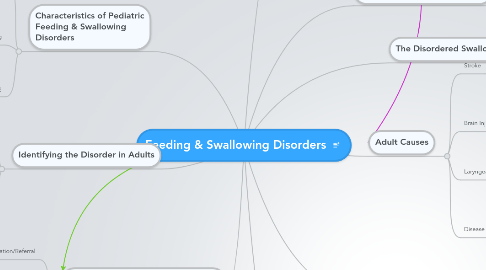
1. Characteristics of Pediatric Feeding & Swallowing Disorders
1.1. Unsafe feeding/swallowing
1.1.1. Results from oral motor system damage or incorrect eating rate
1.1.1.1. Cerebal Palsy
1.1.1.2. Cleft Palate
1.2. Inadequate feeding/swallowing
1.2.1. Refusal to eat
1.2.2. Feeding Delays
1.2.3. Oversensitivity to foods
1.2.4. Lacking nutritional needs due to inability to feed
1.3. Inappropriate feeding/swallowing
2. Identifying the Disorder in Pediatrics
2.1. Early Identification/Referral
2.1.1. Average onset of feeding problems 3mths
2.2. Comprehensive Assessment
2.2.1. Case History
2.2.2. Feeding/Swallowing Evaluation
2.2.3. Mealtime Observation
3. Identifying the Disorder in Adults
3.1. Conduct Clinical Exam
3.1.1. Review medical records
3.1.2. Client Interview
3.1.3. Oral exam
3.1.4. Meal observation
3.1.5. Referral to other professionals if needed
3.2. Dsyphagia Exams
3.2.1. Fiberoptic Endoscopic Exam
3.2.2. Ultrasonography
3.2.3. Videofluoroscopy
4. What is a Feeding and Swallowing Disorder?
4.1. Inadequate Swallowing Patterns
4.2. Growth delays
4.3. Consistently poor apetite
4.4. Inability to tolerate various foods
5. Pediatric Causes
5.1. Prematurity
5.1.1. <32 weeks
5.2. Prenatal Drug Exposure
5.2.1. FAS
5.3. Diet Restrictions
5.3.1. PKU
5.3.2. Diabetes
5.3.3. Metabolic Disorders
5.4. Low Birth Weight
6. The Phases of Normal Swallow
6.1. Oral Prep Phase
6.1.1. moves bolus to back of oral cavity and prepares to moves down the throat
6.2. Pharyngeal Phase
6.2.1. Moves bolus down through throat to esophagus
6.3. Esophageal Phase
6.3.1. Moves bolus through esophagus to stomach
7. The Disordered Swallow
7.1. Dysphagia
7.1.1. When one has difficulty in AT LEAST ONE of the phases of swallowing creating a harmful or inadequate risk to the individual
8. Treatment Goals for Pediatric Patients
8.1. Techniques to improve swallowing coordination
8.2. Using shaping, reinforcement, conditioning and desensitization
8.3. Tube Feeding
8.3.1. Nasogastric Tube
8.3.2. Gastrotomy Tube
8.4. Compensatory Strategies
8.4.1. Intake Modification
8.4.2. Diet Modification
8.4.3. Meal environment/set-up
8.4.4. Alternate eating positions
9. Adult Causes
9.1. Stroke
9.1.1. Cerebral cortex stroke
9.1.2. Lower brain stem stroke
9.1.3. Higher brain stem stroke
9.1.4. Multiple strokes
9.2. Brain Injury
9.2.1. Closed head injury
9.2.2. Open head injury
9.3. Laryngeal Damage
9.3.1. Laryngectomy
9.3.2. Due to radiation/chemotherapy
9.3.3. Trauma
9.4. Disease
9.4.1. Parkinson's Disease
9.4.2. Dementia
9.4.3. Lou Gehrig's Disease
